Section 9.1 Vertical Shifts
Example 9.1. Warm-up.
Suppose \(f(x)\) is given in the table below:
| \(x\) | \(f(x)\) |
| \(-1\) | \(2\) |
| \(0\) | \(3\) |
| \(1.3\) | \(-4\) |
| \(7\) | \(0\) |
| \(14\) | \(1\) |
Now, let's define a new function \(g(x)=f(x)+3\text{.}\) We want to construct the table for \(g(x)\text{:}\)
| \(x\) | \(g(x)\) |
| \(-1\) | |
| \(0\) | |
| \(1.3\) | |
| \(7\) | |
| \(14\) |
To fill in the top row, we need to find \(g(-1)\text{.}\) Based on our definition of \(g(x)\text{,}\) we have that \(g(-1)=f(-1)+3\text{.}\) From the table for \(f(x)\text{,}\) we know that \(f(-1)=2\text{.}\) Therefore,
We can fill out the rest of the table following the same logic:
| \(x\) | \(g(x)\) |
| \(-1\) | \(5\) |
| \(0\) | \(6\) |
| \(1.3\) | \(-1\) |
| \(7\) | \(3\) |
| \(14\) | \(4\) |
Let's compare the two functions we looked at in the warm-up example:
| \(x\) | \(f(x)\) | \(f(x)+3\) |
| \(-1\) | \(2\) | \(5\) |
| \(0\) | \(3\) | \(6\) |
| \(1.3\) | \(-4\) | \(-1\) |
| \(7\) | \(0\) | \(3\) |
| \(14\) | \(1\) | \(4\) |
In \(f(x)+3\text{,}\) we've added \(3\) to the outside of the function, so all of the outputs are increased by \(3\text{.}\) Remember that on a graph, the outputs are represented by the \(y\)-values, so this would increase all of the \(y\)-values by \(3\text{.}\) So, the graph of \(f(x)+3\) would be the same as the graph of \(f(x)\text{,}\) but moved up by \(3\text{.}\)
Definition 9.6. Vertical Shifts.
The graph of \(f(x)+a\) is the same as the graph of \(f(x)\text{,}\) but:
if \(a \gt 0\text{,}\) the graph is moved up
if \(a \lt 0\text{,}\) the graph is moved down
We call this a vertical shift, since "vertical" means "up/down".
See below for an animation of what this transformation does to a graph. If you want to see the animation in a larger window, click here 9 .
Example 9.7.
Below is the graph of \(h(x)\text{:}\)
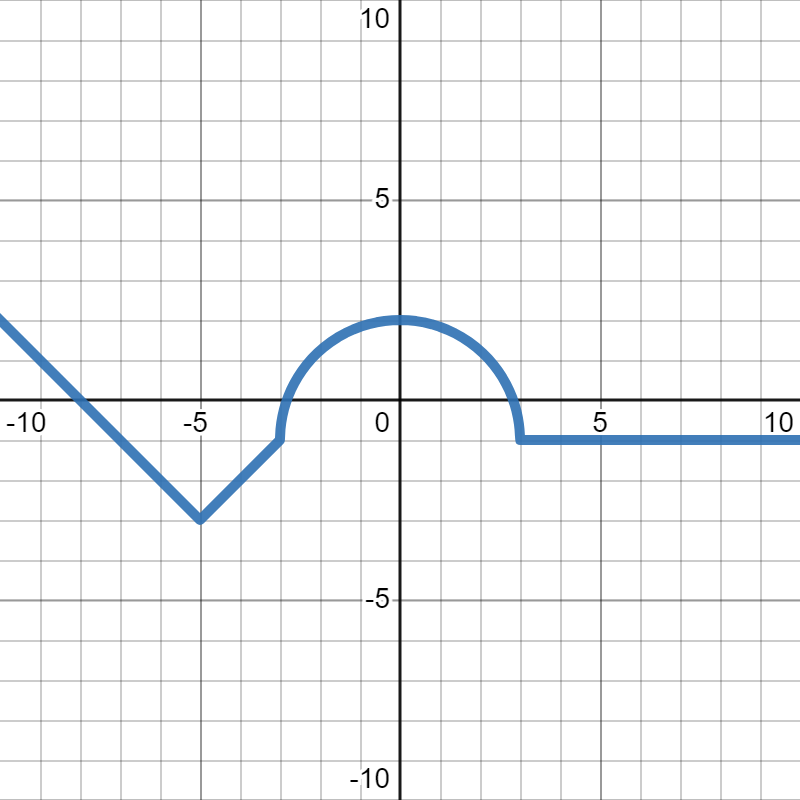
We want to figure out which of the following is the graph of \(h(x)-2\text{.}\) In each, the gray dotted graph is the orignal graph of \(h(x)\) so you can more easily see how it changed.
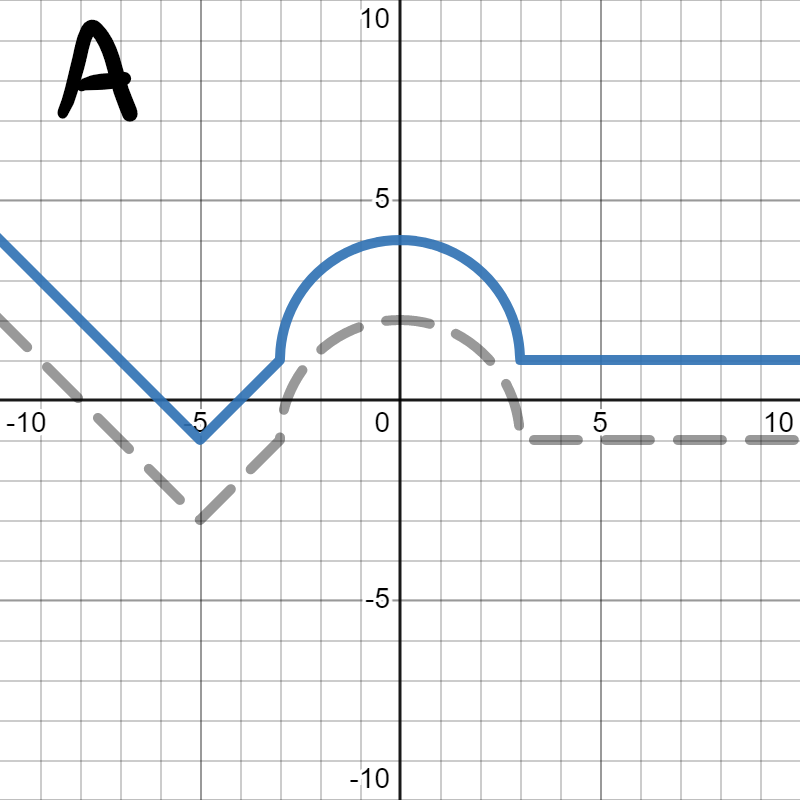
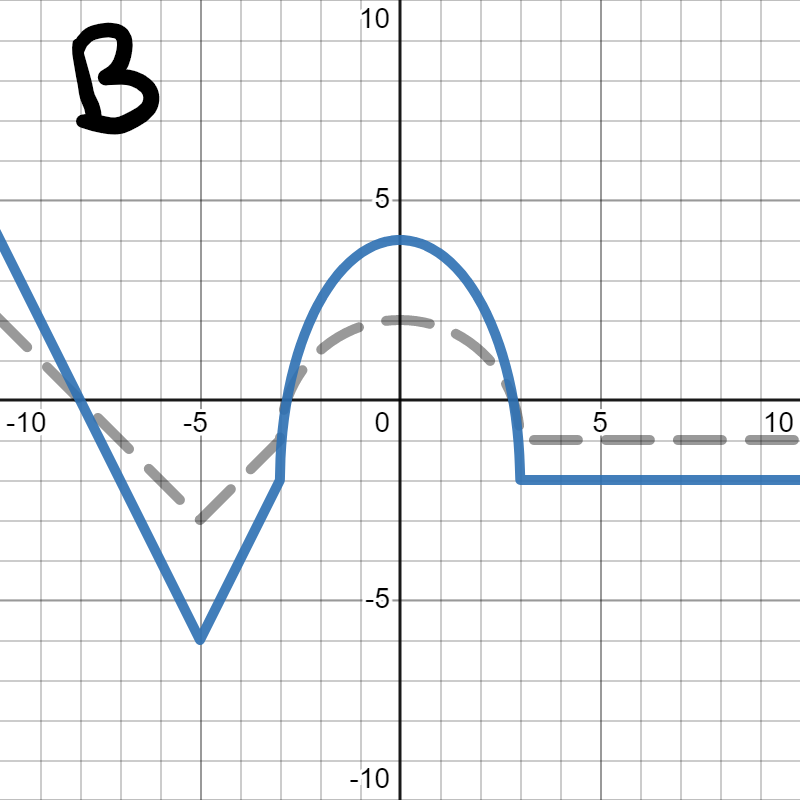
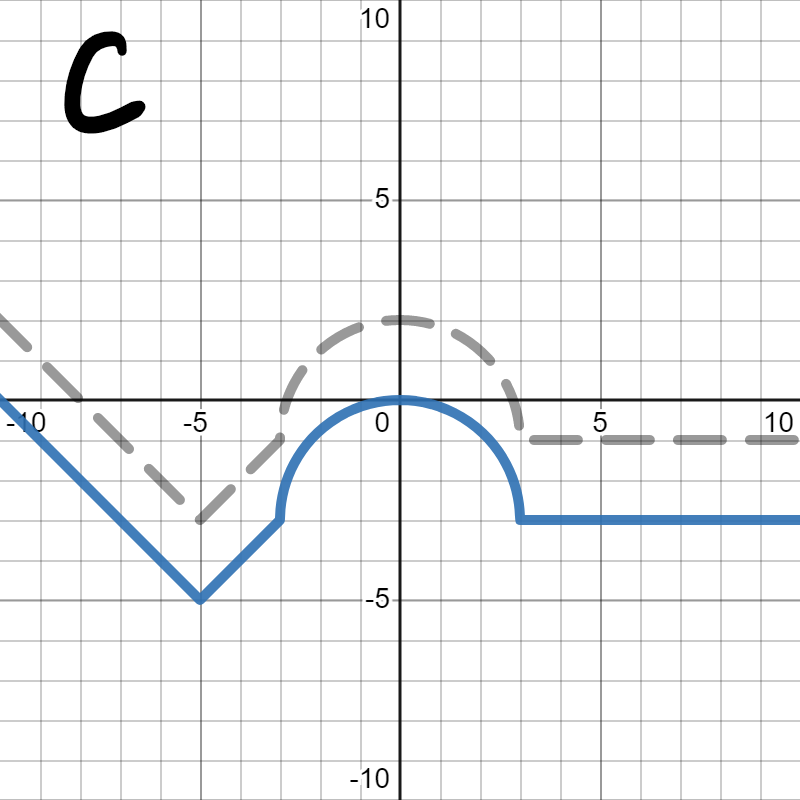
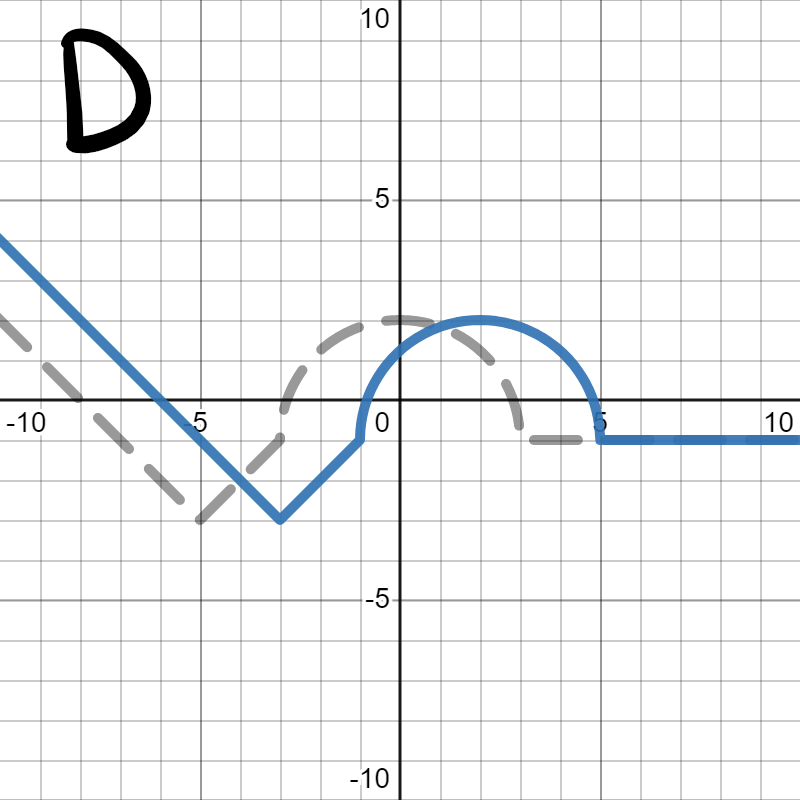
Since we are looking for \(h(x)-2\text{,}\) we are looking for the graph to move down by 2, which is graph C. Graph A shifted up instead of down, which would be \(h(x)+2\text{.}\) Graph B changed the shape of the graph by stretching it, which you'll learn about in Section 9.3. Graph D shifted the graph to the side, which you'll learn about in Section 9.2.
Checkpoint 9.8.
The graph of \(p(x)\) is below:
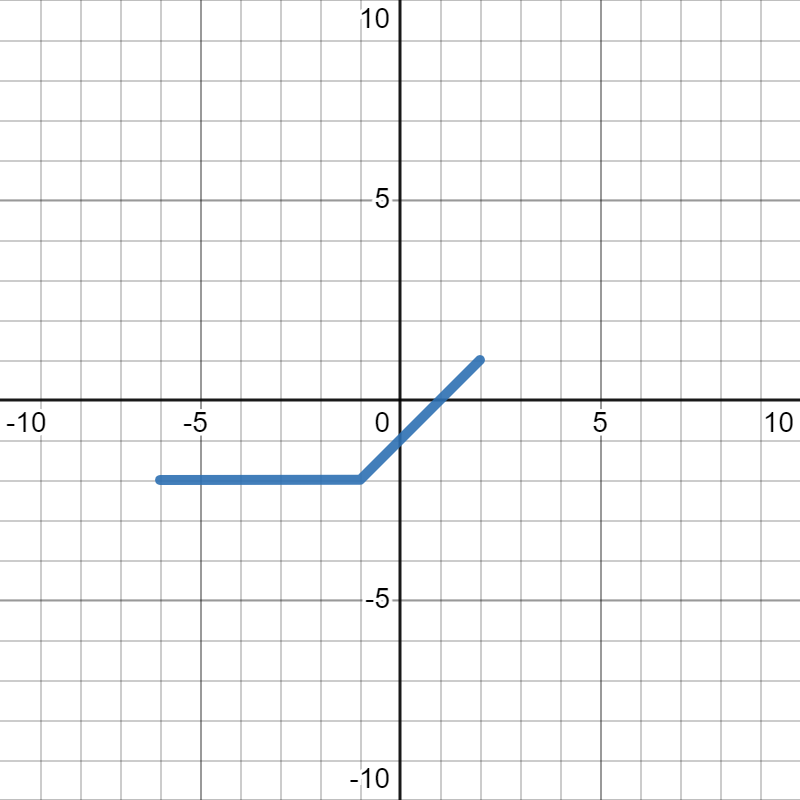
Sketch the graph of each of the following:
\(\displaystyle p(x)-4\)
\(\displaystyle p(x)+1\)
- To draw \(p(x)-4\text{,}\) we see that we are shifting the whole graph down 4. You may find it helpful to move the corner points down first, then connect them together to get the whole graph. So, you would move the point \((-6,-2)\) on the original graph down to \((-6,-6)\text{.}\) Similarly, you would move the point \((-1,-2)\) on the original graph down to \((-1,-6)\) and you would move the point \((2,1)\) on the original graph down to \((2,-3)\text{.}\) From there, you can connect the lines to get the final graph, shown in blue below, where the gray dotted line is the orignal graph of \(p(x)\text{.}\)
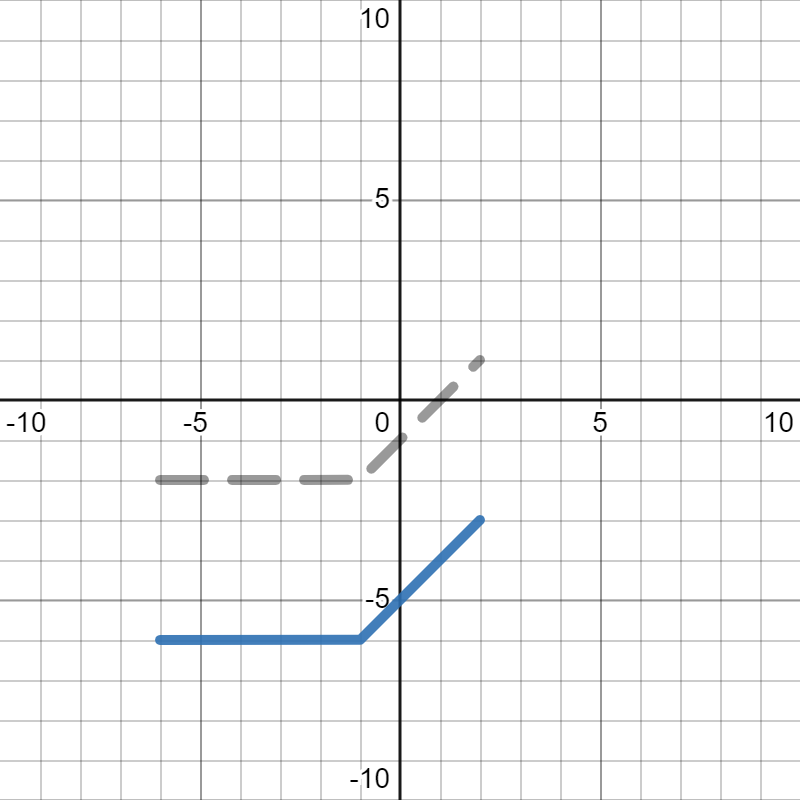
- To draw \(p(x)+1\text{,}\) we see that we are shifting the whole graph up 1. You may find it helpful to move the corner points up first, then connect them together to get the whole graph. So, you would move the point \((-6,-2)\) on the original graph up to \((-6,-1)\text{.}\) Similarly, you would move the point \((-1,-2)\) on the original graph up to \((-1,-1)\) and you would move the point \((2,1)\) on the original graph up to \((2,2)\text{.}\) From there, you can connect the lines to get the final graph, shown in blue below, where the gray dotted line is the orignal graph of \(p(x)\text{.}\)
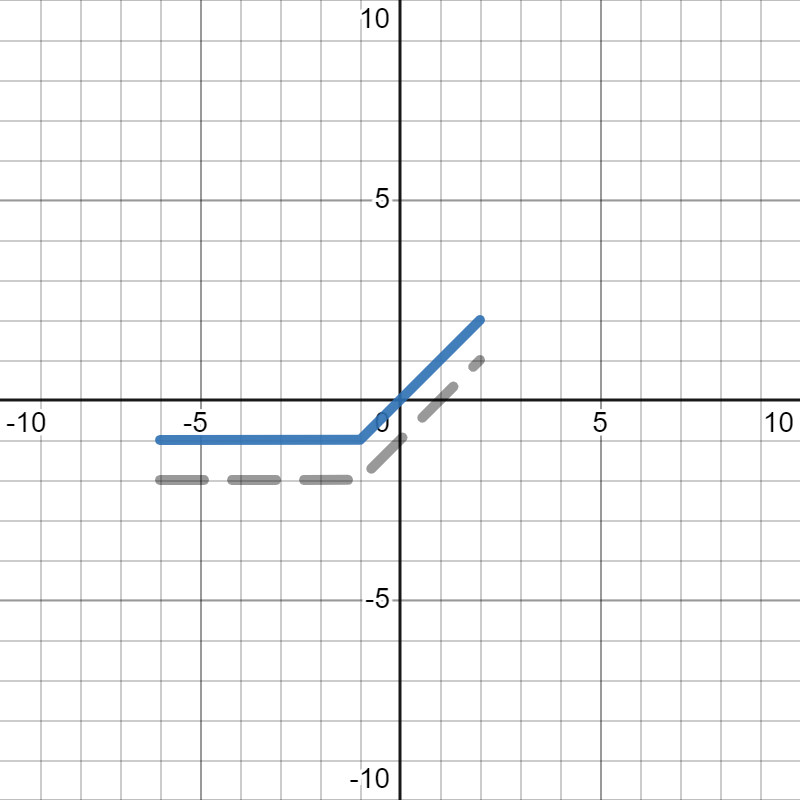
Example 9.9.
Suppose the solid blue graph below is the graph of \(f(x)\) and the dotted red graph is the graph of \(g(x)\text{:}\)
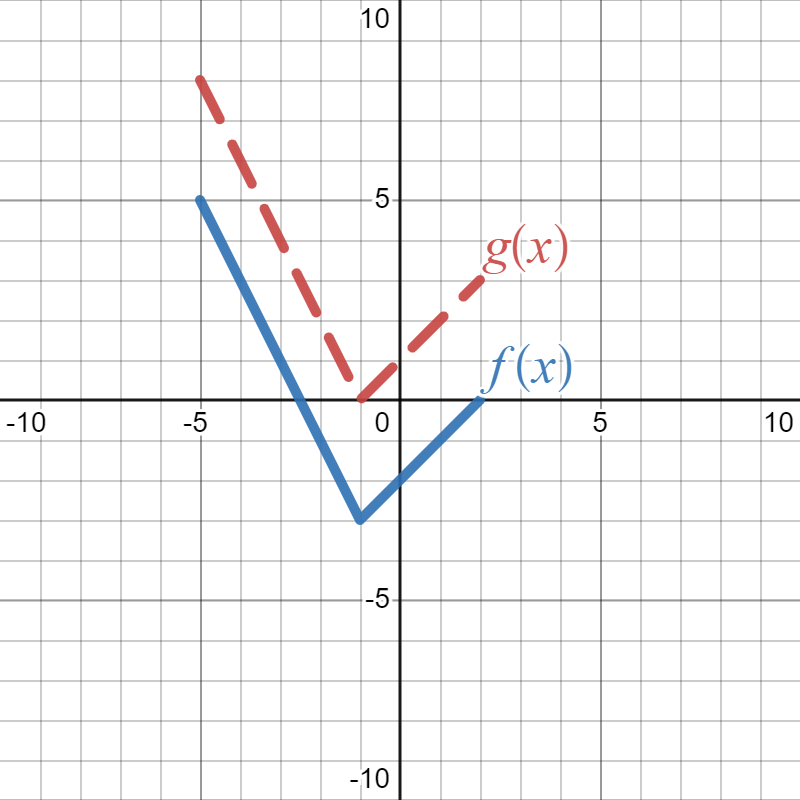
We want to write a formula for \(g(x)\) in terms of \(f(x)\text{.}\) In other words, we start with \(f(x)\) and figure out how the graph changed to get to \(g(x)\text{,}\) then write how that changes the formula. Since the question asks for the formula "in terms of \(f(x)\)", that means we will write \(f(x)\) somewhere in our answer. Looking at the graph, we see that \(g(x)\) is the graph of \(f(x)\) shifted up by \(3\text{.}\) Therefore, that means we are adding \(3\) to the outside of the function \(f(x)\text{.}\) So, our final answer is \(g(x)=f(x)+3\text{.}\)
Checkpoint 9.10.
Suppose the solid blue graph below is the graph of \(f(x)\) and the dotted red graph is the graph of \(g(x)\text{:}\)

Write a formula for \(g(x)\) in terms of \(f(x)\text{.}\)
\(g(x)=f(x)-4\)
We want to write a formula for \(g(x)\) in terms of \(f(x)\text{.}\) In other words, we start with \(f(x)\) and figure out how the graph changed to get to \(g(x)\text{,}\) then write how that changes the formula. Since the question asks for the formula "in terms of \(f(x)\)", that means we will write \(f(x)\) somewhere in our answer. Looking at the graph, we see that \(g(x)\) is the graph of \(f(x)\) shifted down by \(4\text{.}\) Therefore, that means we are subtacting \(4\) from the outside of the function \(f(x)\text{.}\) So, our final answer is \(g(x)=f(x)-4\text{.}\)
Example 9.11.
Suppose \(f(x)=x^2+3x-4\) and \(g(x)\) is the same as \(f(x)\) but shifted up \(7\text{.}\) Let's write a formula for \(g(x)\text{.}\) Since we have an explicit formula for \(f(x)\) in this case, we can write an explicit formula for \(g(x)\text{,}\) too. Since we are shifting up by \(7\text{,}\) that means we are adding \(7\) to the outside of the function. So,
So our final answer is \(g(x)=x^2+3x+3\text{.}\)
Checkpoint 9.12.
Suppose \(f(x)=3x^3-2x+1\) and \(g(x)\) is the same as \(f(x)\) but shifted down by \(4\text{.}\) Write a formula for \(g(x)\text{.}\)
\(g(x)=3x^3-2x-3\)
Since we have an explicit formula for \(f(x)\) in this case, we can write an explicit formula for \(g(x)\text{,}\) too. Since we are shifting down by \(4\text{,}\) that means we are subtracting \(4\) from the outside of the function. So,
So our final answer is \(g(x)=3x^3-2x-3\text{.}\)
Example 9.13.
Suppose \(f(x)=x^2-x+5\) and \(g(x)=x^2-x+3\text{.}\) Let's figure out what transformations took \(f(x)\) to \(g(x)\text{.}\) Comparing the two formulas, we see that \(g(x)\) only has \(3\) added at the end, but \(f(x)\) has \(5\) added at the end. That means that to get from \(f(x)\) to \(g(x)\text{,}\) we must have subtracted \(2\) to the outside so that \(g(x)=f(x)-2\text{.}\) That means there was a shift down by \(2\text{.}\)
Checkpoint 9.14.
Suppose \(f(x)=3x+2\) and \(g(x)=3x-4\text{.}\) What transformations took \(f(x)\) to \(g(x)\text{?}\)
Shift down by \(6\text{.}\)
Comparing the two formulas, we see that \(g(x)\) only has \(4\) subtracted at the end, but \(f(x)\) has \(2\) added at the end. That means that to get from \(f(x)\) to \(g(x)\text{,}\) we must have subtracted \(6\) to the outside so that \(g(x)=f(x)-6\text{.}\) That means there was a shift down by \(6\text{.}\)
https://www.desmos.com/calculator/9alk4oa8bn